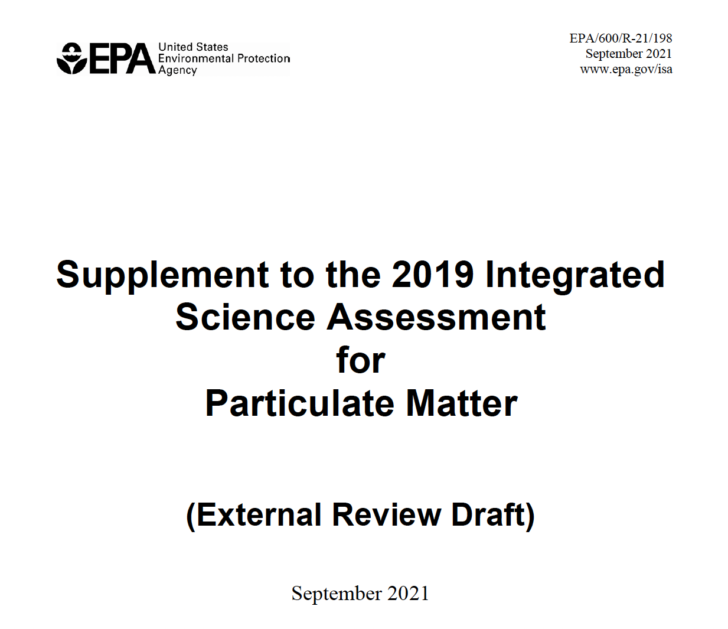Below is my testimony at today’s public meeting of EPA’s CASAC PM subpanel concerning EPA’s updated assessment of PM2.5 science. Not surprisingly, the EPA air pollution mafia declined my challenge to point out where I was wrong… because I’m not. Former UCLA epidemiologist Jim Enstrom also provided great comments. They are here. EPA’s CASAC PM subpanel failed to ask Enstrom any questions about his testimony either. Please support JunkScience.com!

Good afternoon. I am Steve Milloy. I publish JunkScience.com.
EPA’s assessment of the PM2.5 science is a case study in science fraud.
First, the PM epidemiology is not science — it’s just statistics and dishonest statistics at that.
Statistical associations by themselves are not science.
EPA admitted in federal court with me that the PM epidemiology alone is inadequate for determining causality.
That should be no surprise.
It’s basic epidemiology – not that the PM epidemiology is worth anything to start with.
In fact, the data used in the PM epidemiology are mostly garbage.
The exposure data are poorly guesstimated and often overwhelmed by other PM exposures, especially smoking, occupational exposures and indoor air.
PM health endpoints like mortality are common and multifactorial, and so are not plausibly studied via epidemiology.
It’s no wonder that EPA allows agency grantees to hide their data from public scrutiny.
Even so, all the PM epidemiology essentially reports zero correlations.
Honest epidemiologists know that epidemiology is only useful for studying high rates of rare disease – not low rates of common health endpoints like death.
And let’s not forget that EPA staff continues to essentially ignore all the PM epidemiology that expressly reports no association between PM and death like the 2017 study by Young, Smith and Lopiano that considered every death, two million of them, that occurred in California between 2000-2012 and reported no association between PM and deaths.
Let’s consider at PM toxicology which should be able to shed light on whether there is any biological plausibility to the notion that PM kills.
There is no lab animal experiment that has produced deaths in animals – despite intense PM exposures.
There is no human clinical experiment that has produced health effects – let alone deaths – despite exposing elderly and sick people to intense PM.
None of this is surprising since there are no real-world examples where PM has killed anyone ever.
Yet EPA staff dishonestly assesses this body of literature as supporting its false assertion that PM causes death.
Please EPA, show us the body of someone who has been killed by PM. Just one, please. Aren’t you even curious yourselves? There are supposed to be 8 million deaths worldwide caused by PM2,5. And you can’t find a single body?
Studies show that smokers who quit by age 40 will have inhaled thousands of times more PM than nonsmokers – yet both groups have the same life expectancy.
PM levels in Chinese and Indian cities can be 100 or more times greater than US outdoor air – but there are no reports of actual deaths from inhaling Chinese or Indian air.
Historic incidents of deadly air pollution during the 20th century were caused by acidic gases concentrated in the air by weather phenomena.
They weren’t caused by PM2.5.
Coal miners and diesel workers have relatively large exposures to PM – but they have greater life expectancy than workers not occupationally exposed to PM.
And guess what, when PM levels are reduced, deaths don’t go down.
Yet, EPA staff ignores this real-world data, doubles down on the fraudulent and secret science and raves that PM2.5 is more dangerous than ever.
It’s a shameless con. And it’s getting worse.
EPA staff now claims that the cleaner air is, the more dangerous it is.
EPA staff claims that when it comes to cardiovascular mortality, the dose-response curve goes supralinear at low doses.
Of course that would mean that tightening the PM2.5 NAAQS would actually kill people.
There is not a single toxic substance known to science that operates on the principle that a little exposure is worse than a lot. Not a single one.
All the foregoing is indisputable. At least I have no seen anyone dispute it.
So how did all this fraud take hold in the first place?
Since 1996 – the first time CASAC told EPA that there is no evidence PM2.5 kills – EPA staff has funneled at least $600 million to university researchers willing to commit scientific fraud in order to invent and maintain the lie that PM kills.
After the 1996 CASAC debacle, EPA staff saw to it that future CASAC review boards were staffed and controlled by the same researchers funded to commit the PM science fraud.
And that’s what happened until CASAC was reformed in the last administration.
Now we are back to the good old days of EPA’s CASAC cronies doing the bidding of EPA staff and rubber-stamping their fraudulent interpretation of the PM2.5 literature and reality.
If I am wrong about any of what I have just said. I’d love to hear about it.
But I know you won’t dare.
You will just hide behind conclusory statements in thousand-page long unreadable summary documents, byzantine process, paid-off academia and a media that is as dumb as EPA is dishonest.
Thank you for your attention.
A Great summing-up of the situation.
We Scientific / Technical guys with no legal education have no idea about what can be asserted without committing libel.
We try to ‘tell it like it is’ but we have to steer clear of doing this for fear of litigation….
Our challenges to the establishment consequently end up lacking ‘punch’ and get brushed off by the public Tribunals / Commissions-of-inquiry et al……..
‘The world is not fair, and often fools, cowards, liars and the selfish hide in high places.”………Anon.